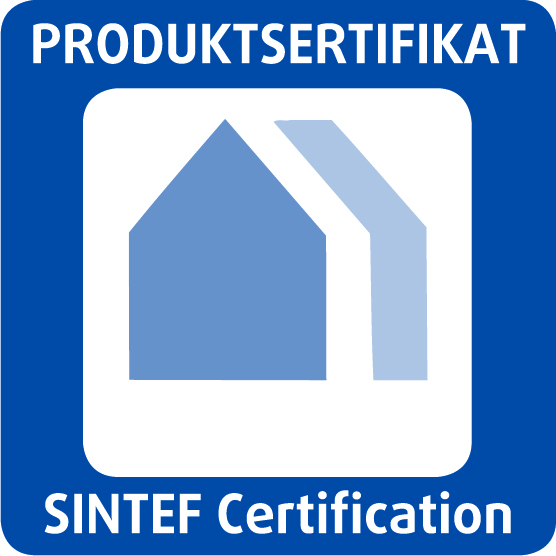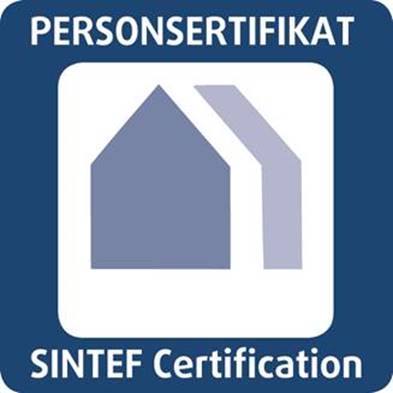European CPR certificate as the basis for CE marking
CPR certificates in
accordance with the Construction Products Regulation (CPR) are issued as a
basis for CE marking of construction products where the European Construction
Products Regulation requires such certification. The regulation specifies
various systems for assessing and declaring construction products' properties
(Assessment and Verification of Constancy of Performance, AVCP). This
system applies to the individual construction product and is specified by the
harmonized product standard of the product type, or in the ETA (European
Technical Assessment) for a specific construction product. For systems
that require a CPR certificate, this applies to either certification of the
factory's production control or certification of the product itself. SINTEF
Building and Infrastructure is designated as a certification body for a number
of construction products.
Application form for SINTEF product certification
Requirements in the legislation on the documentation of construction products
Regulations on turnover and documentation of products for construction works (DOK) came into force on 1 January 2014 and have been introduced as part of the implementation of the Construction Products Regulation (Regulation 305/2011 / EU from the European Parliament and the European Council of 9 March 2011) in Norway. The Building Products Regulation and DOK require documentation of product properties that are relevant to the basic functional requirements for building structures:
- Mechanical resistance and stability
- Fire safety
- Hygiene, health and environment
- Safety and availability in use
- Protection against noise
- Energy economy and thermal insultation
- Sustainable use of natural resources.
Manufacturers shall provide the necessary documentation of the characteristics of the products and shall submit to documentation and control systems that ensure that the product conforms to the technical specifications underlying the production and control of the product. This Confirmation of Conformity forms the basis for the CE marking of the product .
Systems for assessment and verification of construction products' performance
The construction product regulation specifies five different systems for verification of conformity. This system applies to a construction product and is listed either in Annex ZA in the harmonized product standard for the construction product, or in the ETA for the construction product, where such documentation is prepared. The term type test must also include calculations where applicable.
The three most stringent systems, i.e. systems 2+, 1 and 1+, require the existence of a CPR certificate. In system 2+, the factory's production control must be certified and supervised by a technical inspection body designated as certification body for the relevant construction product. In systems 1 and 1+, the product itself must be certified by a designated certification body.
In system 3, only a test report from the type test is required by a designated testing body, but no certification. In system 4, the manufacturer can do all the tasks himself.
Compliance Verifcation Systems Table
Fig 1. System for assessment and verification of construction of construction products' performance
SINTEF Community: A technical inspection body
The Norwegian authorities at the Directorate for Building Quality (DiBK) have designated SINTEF Building and Infrastructure as a technical inspection body, in accordance with the Construction Products Regulation. SINTEF's identification number is 1071. The designation includes rights to perform conformity assessments of products in more than 30 product areas. SINTEF Building and Infrastructure is also accredited by Norwegian Accreditation for the certification of products in accordance with harmonized standards, as well as other requirements in documents subject to the Construction Products Regulation, with accreditation number PROD 007.
Certification of load-bearing components in steel and aluminium
SINTEF Building and Infrastructure is accredited and designated as a technical inspection body for certification in accordance with NS-EN 1090-1 "Execution of steel structures and aluminium constructions".
Certificates can be issued after a first-time inspection and require ongoing inspections of the production. Certification according to the requirements of NS-EN 1090-1 is the basis for CE marking.
Components of steel and aluminium must be CE marked if they are covered by an EN 1090-1 and are not on CEN's list of products that do not need to be certified .
The component must be a 'load-bearing construction component' according to the Construction Products Regulation (CPR), which means that:
- the product is included permanently in the construction works
- the product has a bearing function in the construction work, i.e. that the products' failure will affect the structure's mechanical resistance and stability.
The component cannot be covered by the scope of another harmonized standard or ETA.
Initial factory check
Before a CPR certificate can be issued for systems 2+, 1 and 1+, the certification body must visit the factory to check and accept the internal production control for that product. This also includes the approval of production and control equipment.
Monitoring production control
After a CPR certificate is issued, a designated inspection body will regularly visit the factory and verify that both the manufacturer's production control is working, and that the conditions for the certificate are still present. The number of visits is specified in the relevant product standard or in the basis of ETA and is usually annual. For products that are subject to System 1+ for Confirmation of Conformity, the control must also include samples of the product's properties.
Marking
In order to show that a product is certified, i.e. in compliance verification in system 1 or 1+, certification marks are issued with certification number. The labels can be used on the product itself, the packaging and in marketing.
A certification mark is not normally issued for compliance 2 in system 2+.
Validity
Certificates are generally given an instant validity but must be formally renewed with a new certificate no fewer than once every five years. A contract is signed between SINTEF Certification and the holder to ensure follow-up and any necessary revision, in case of changes in the product, production or other matters that are of importance to the certificate. If the changes are considered significant, the certificate is withdrawn.
Publishing
CPR certificate holders may even multiply their certificates as needed. Certificates issued by SINTEF Building and Infrastructure are published on www.sintefcertification.no.
Application for certification
Application form for SINTEF product certification
SINTEF Community
If there is no harmonized standard or ETA for a product that nevertheless requires a CPR certificate, a SINTEF Product Certificate or a SINTEF Technical Approval may be issued.






